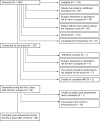Preoperative Patient Expectations of Postoperative Pain Are Associated with Moderate to Severe Acute Pain After VATS
- PMID: 29878248
- PMCID: PMC6657569
- DOI: 10.1093/pm/pny096
Preoperative Patient Expectations of Postoperative Pain Are Associated with Moderate to Severe Acute Pain After VATS
Abstract
Objective: The goal of this post hoc analysis of subjects from a prospective observational study was to identify the predictors of patients developing moderate to severe acute pain (mean numerical rating scale [NRS] ≥4, 0-10) during the first three days after video-assisted thoracoscopic surgery (VATS) from a comprehensive evaluation of demographic, psychosocial, and surgical factors.
Methods: Results from 82 patients who were enrolled one week before VATS and evaluated during the first three postoperative days are presented. The primary outcome variable of the current study was the presence of moderate to severe acute pain after VATS.
Results: Fifty-nine percent (95% confidence interval, 47-69%) of study subjects developed moderate to severe acute pain after VATS. Factors univariately associated with the presence of moderate to severe acute pain were greater average expected postoperative pain, greater pain to a suprathreshold cold stimulus, and longer durations of surgery and hospital stay (P < 0.05). When considered in the multiple logistic regression models, the patients' preoperative average intensity of expected postoperative pain (NRS, 0-10) was the only measure associated with the moderate to severe acute pain. Average intensity of postoperative pain expected by patients when questioned preoperatively mediated the effect of reported intensity of pain to the suprathreshold cold stimulus for moderate to severe acute pain levels. Preoperative patient expectations had greater predictive value than other assessed variables including psychosocial factors such as catastrophizing or anxiety assessed one week before surgery.
Conclusions: None of the preoperative psychosocial measures were associated with the moderate to severe acute pain after VATS. Average expected postoperative pain was the only measure associated with the development of moderate to severe acute pain after VATS.
Keywords: Acute Pain; Multiple Logistic Regression; Predictors; Thoracic Surgery; VATS.
© 2018 American Academy of Pain Medicine. All rights reserved. For permissions, please e-mail: journals.permissions@oup.com.
Figures



References
-
- The Society of Thoracic Surgeons. The Society of Thoracic Surgeons General Thoracic Surgery Database. Chicago: The Society of Thoracic Surgeons; 2011.
-
- The Society of Thoracic Surgeons. The Society of Thoracic Surgeons General Thoracic Surgery Database, 2016. Chicago, IL: The Society of Thoracic Surgeons; 2017.
-
- Whitson BA, Andrade RS, Boettcher A, et al. Video-assisted thoracoscopic surgery is more favorable than thoracotomy for resection of clinical stage I non-small cell lung cancer. Ann Thorac Surg 2007;836:1965–70. - PubMed
-
- Hanna WC, de Valence M, Atenafu EG, et al. Is video-assisted lobectomy for non-small-cell lung cancer oncologically equivalent to open lobectomy? Eur J Cardiothorac Surg 2013;436:1121–5. - PubMed
Publication types
MeSH terms
Grants and funding
LinkOut - more resources
Full Text Sources
Other Literature Sources
Medical

